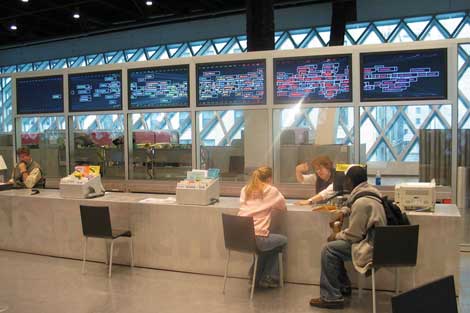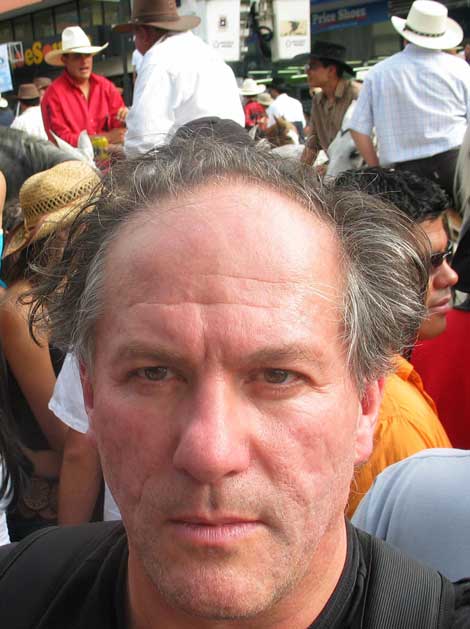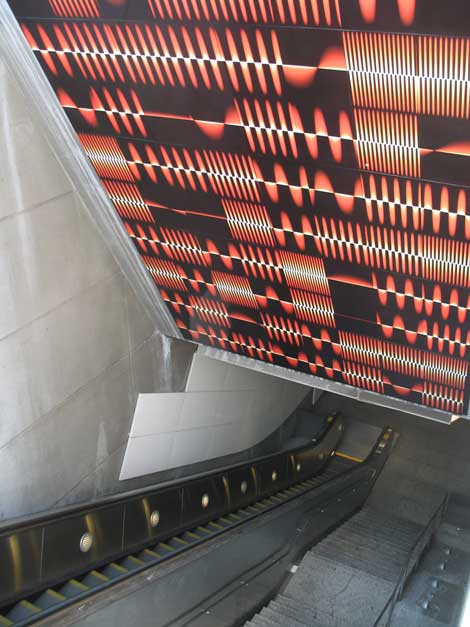Tracking down George Legrady for an interview can be tricky. A man who juggles art and science for a living has a lot of demands on his time. Hence, I found myself at a panel discussion on Database Aesthetics at the convention center in Los Angeles early one Saturday morning. The room was packed and I had to sit on the floor. Legrady was one of the panelists whose area of expertise is Data Visualization. I’m not going to pretend I know half of what the panel was talking about, so here’s the “Data Technology for Dummies” version.
I first met Legrady when I was a grad student at USC in 1986. He taught photography and was one of those professors who would hang out with the grad students and come to our openings and drink beers. Legrady was never into conventional photography; he was more interested in his soundboards and computers and signals from the music he played. Since he was so brainy, he came off like an absent-minded professor type, only hip, handsome and European-chic (he’s originally from Budapest, then lived in Montreal). At that time, Legrady was easily riding the crest of digital art and technology, and modestly points out he was “one of the early artists who worked with multilinear digital narrative.” Who am I to argue?
Before USC, Legrady taught at UC San Diego, where he met Harold Cohen, a first-generation computer artist in the early ’70s. Cohen developed AARON, a digital program that painted abstract paintings much like his own. Legrady feels indebted to him: “I met him at a party, and he gave me a key to his studio, and I was in there for four years and learned everything.” This is when Legrady discovered computer programming, never to return from cyberspace.
Legrady describes his art as Data Visualization and claims he has been collecting information forever, even with his photography in college when he was working with conceptual issues. “It’s always been data. I might look at how business handles data. I might look at how NASA handles data. How people in shops handle data,” Legrady explains. “I begin with real data. I’m always playing between what is real and what are ways to represent something.” Could Legrady be a Dataist?
A perfect example of how Legrady works with data is an interactive installation currently on view at Rem Koolhaas’ Public Library in Seattle. Legrady installed it in 2005 and it will be in operation until 2014. Quite simply, every time someone checks out a book, it analyzes the data. Legrady explains, “What I try to show is what the community is thinking. It’s more interesting to look at what we don’t see.” He also points out proudly, “The librarians love it.” They can look up at the screens and see which books are the most popular at any given moment. An information exchange extravaganza!
Legrady is currently a professor in the department of Media Arts & Technology (MAT) at UC Santa Barbara. MAT is very unique in the UC system as it is a true arts-engineering interdisciplinary graduate/PhD program. The faculty consists of computer scientists, electrical engineers and electronic composers. The media arts area includes Legrady (data visualization), Marcos Novak (architect), Marko Peljhan (activist media arts) and Lisa Jevbratt (data visualization and interspecies communication). In addition to his teaching career, Legrady is constantly flying all over the world to serve on panels and lectures, not to mention working on his several ongoing art projects.
My burning question to Legrady is why are artists who are so interested in science not scientists? Legrady indulges me: “There’s a lot of interest today — it’s kind of trendy — to have artists and science work together, but the scientists say it’s not science, and the artists say it’s not art. So, what is it? It’s kind of like a meeting point where artists are looking at science as a source of inspiration for material. Scientists are explorers of the universe; artists are people who reflect on how these scientific things have an impact. So, it’s an interesting conversation, and everyone hopes that it will lead to a new kind of hybrid, like an interdisciplinary artist scientist, or artist engineer. It’s really challenging, because you need to have the knowledge base of both, and that’s a lot of knowledge.”
I’m still skeptical. I can see why artists might be attracted to science, but I don’t see why scientists would care much for having artists involved in their activities. Are artists just using science to validate their projects? “I’m not so sure,” Legrady says. He observes that a lot of his colleagues are activists. “They are interested in environment, they are interested in biology, how research in animals takes place, so there’s a kind of political activism to it.”
Legrady goes on to squelch my cynicism. “Let’s say you want to discover how many bubbles you have in your bathtub or bubble bath — there’s a scientific method that’s been developed. That’s what scientists do. And when they look at art, they can’t figure out how to evaluate it, so it’s outside of their world. Like beauty, how do you evaluate what is beautiful? So, artists work with beauty, or not.
“Scientists want to discover the phenomena of life, of the world — that’s what scientists do. Engineers make things work. Artists are in this open zone. We can explore the aesthetics and the poetics of something. They can use stuff to create political activism, political change.”
Or figure out how many bubbles are in the bubble bath.
George Legrady is represented by Edward Cella Art + Architecture in Los Angeles. He is currently featured at the Plug-In alternative gallery in Basel, Switzerland, until the end of May and will have a solo retrospective at the Sprengel Museum in Hanover, Germany, next year.
This article was originally published in May, 2009.




